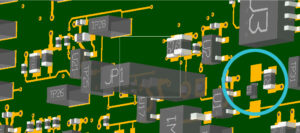When designing the layout of your product’s electronic circuit board, proper component placement is of paramount importance. Whether your company invests in DFM software or collaborates with a Contract Manufacturer (CM) that provides this service, adhering to best practices in board layout during the design phase is essential. In this write-up, we’ll explore how DFM and optimal component placement play a crucial role in mitigating PCB issues, reducing manufacturing costs, and enhancing the long-term success of your product.
Mitigating PCB Issues:
Less than ideal component placement can lead to a host of PCB and assembly issues, such as overheating, electrical shorts, signal interference and assembly defects. These unexpected problems during manufacturing can result in production delays and increased expenses. However, by conducting DFM analysis in the pre-production phase, you can uncover and address these design issues proactively, protecting the quality and reliability of your finished product. Investing in DFM analysis may incur an initial cost, but the benefits of avoiding production issues far outweigh the expense of the review.
reliability of your finished product. Investing in DFM analysis may incur an initial cost, but the benefits of avoiding production issues far outweigh the expense of the review.
Reducing Manufacturing Costs:
Suboptimal component placement can create unnecessary assembly manufacturing challenges, leading to increased labor costs and production delays. By considering DFM principles and ensuring proper component placement, you can streamline the manufacturing process and minimize labor-intensive tasks. This, in turn, translates into cost savings and a more efficient production cycle, benefiting your company’s bottom line.
Impact on Repair and Maintenance:
Your design choices can significantly impact the repair and maintenance processes of the product. If components are poorly placed and inaccessible during routine maintenance or repairs, it can result in longer downtime for your customers and increased costs for your company. To avoid these issues, engaging in open communication with your Contract Manufacturer is crucial. Discussing considerations like component accessibility during the design phase ensures that your product is not only well-designed but also easy to service, enhancing customer satisfaction and reducing long-term maintenance costs.
Strategic Decision for Long-Term Success:
Investing time and effort into proper component placement and DFM analysis during the design phase is a strategic decision that yields significant benefits in the long run. By proactively addressing potential issues, you can avoid production delays, reduce manufacturing costs, and enhance the overall reliability of your product. Partnering with a reliable Contract Manufacturer and engaging in thorough DFM analysis provides valuable insights that lead to a high-quality electronic circuit board, meeting performance expectations and surpassing customer satisfaction.
In conclusion, optimizing component placement through DFM analysis is vital for the success of your product. By uncovering and addressing design issues early on, you can avoid PCB problems, reduce manufacturing costs, and ensure customer satisfaction. Collaborating with a Contract Manufacturer that emphasizes DFM principles allows you to leverage their expertise and streamline the production process. A well-designed PCB not only ensures seamless production but also contributes to the long-term success of your product in the marketplace, solidifying your position as a reliable and innovative industry player.
vital for the success of your product. By uncovering and addressing design issues early on, you can avoid PCB problems, reduce manufacturing costs, and ensure customer satisfaction. Collaborating with a Contract Manufacturer that emphasizes DFM principles allows you to leverage their expertise and streamline the production process. A well-designed PCB not only ensures seamless production but also contributes to the long-term success of your product in the marketplace, solidifying your position as a reliable and innovative industry player.











